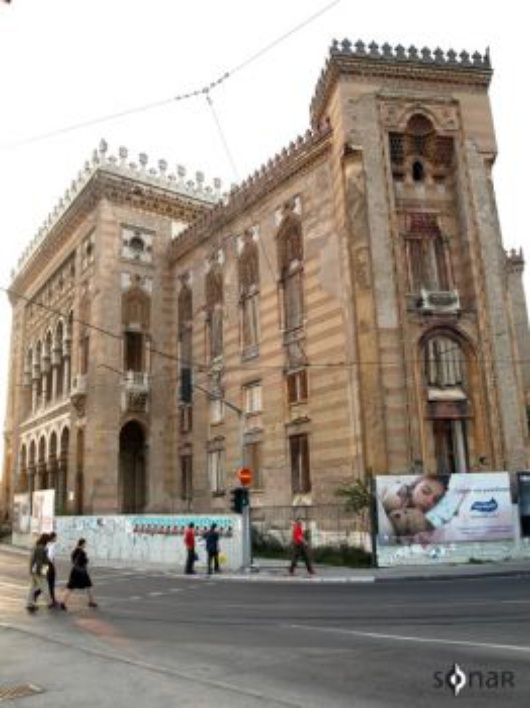The Loss of Books- A Bosnian Story
Published on
By Therese Sampietro Though one film at this year’s film festival told the uplifting tale of how a library was saved, the true story of Bosnia’s books is much sadder.
The Audience Award for best documentary film in the 17th annual Sarajevo Film Festical went to Sam Hobkinson’s film The Love of Books-A Sarajevo Story.
Using interviews, original footage and dramatized scenes, it tells the story of how over 10,000 manuscripts and rare books belonging to the Gazi Husrev Beg library were saved during the siege of Sarajevo.
 Gazi Husrev Beg, a ruler of Bosnia in the first half of the 16th century, was the greatest benefactor of Sarajevo. He funded the building of the mosque that bears his name, a medressa and many other buildings. A generous endowment was given to found the library. Over time it grew to house thousands of manuscripts and old books.
Gazi Husrev Beg, a ruler of Bosnia in the first half of the 16th century, was the greatest benefactor of Sarajevo. He funded the building of the mosque that bears his name, a medressa and many other buildings. A generous endowment was given to found the library. Over time it grew to house thousands of manuscripts and old books.
In 1992, as Serb nationalist forces besieged the city, Dr. Mustafa Jahić worried for the fate of the library he directed. He decided to move the most important books somewhere safe from the shellfire. But in a time of war, it wasn’t such an easy task. Together with a guard, a cleaning lady and a few others, they carried the books from one location to another, each time risking their lives. In the end, they survived and so did the books.
The most unbelievable part of the story has to do with one particular manuscript, A History of Bosnia, written in Turkish in the 19th century by Salin Hadžihuseinović-Muvvekkit. Shortly before the outbreak of the war, Dr. Lamija Hadžiosmanović borrowed the four volumes and took them home to begin translating them. But, in the spring of 1992, she was forced to leave her home, taking with her only a few personal belongings. The manuscript was left in her flat and Grbavica, the part of town where she lived, soon fell to the Serb nationalist army.
Four years later, in the spring of 1996, Dr. Hadžiosmanović finally returned home. Her apartment had been used by the occupying soldiers during the siege and was all but empty. Walking through her destroyed home she stopped to sift through the small pile of what was left of her ruined belongings. She picked up a dust covered platter from Egypt and there, underneath, unharmed, were all four volumes of Muvvekkit’s history. Even Hollywood couldn’t have done better.
So, the movie ends. But several hundred meters from the Gazi Husrev Beg library, hidden behind scaffolding and draped in tatters, stands a building that tells another, sadder story.
Vijećnica, or Town Hall, was built in 1896. It was one of the first buildings erected by the new Austro-Hungarian authorities. Designed in the pseudo-Moorish style, but still seeming somehow Austrian, the building served as the seat of city government for the first half of the 20th century. After the Second World War, the building became home to the national and university libraries.
On the night of August 24th 1992 gunfire from the hills surrounding Sarajevo lit Vijećnica afire. Low water pressure made extinguishing the flames impossible, so fire-fighters and residents tried to save what books they could. Though they carried some 100,000 books from the burning building, almost 2 million publications - ninety-percent of the library’s archives- were lost, including more than 150,000 manuscripts and rare books.
The destruction of Vijećnica was not just another casualty war. All over Bosnia, books had become the target of nationalist armies. In Sarajevo, 15,000 manuscripts from the Oriental Institute were destroyed, along with 50,000 books in the Franciscan Theological Seminary Library. The scenario was repeated in other cities in Bosnia.
The destruction of these libraries was a clear attempt to erase the reality of Bosnia’s history. The lies supporting nationalist agendas could not be passed off as truths while so much proof existed of Bosnia’s multi-ethnic heritage and of its long history as a sovereign and independent state. Books are never silent and as long as they existed, so did the truth.
 But the National Library was targeted as much for its form –a fusion of European and oriental designs- as for what lay inside. Unlike other famous buildings in Sarajevo, Vijećnica cannot be associated with any one group or religion. It truly represents the unique mixture that is Bosnia and though before some felt it was ugly and tacky, now everyone agrees that it must be rebuilt.
But the National Library was targeted as much for its form –a fusion of European and oriental designs- as for what lay inside. Unlike other famous buildings in Sarajevo, Vijećnica cannot be associated with any one group or religion. It truly represents the unique mixture that is Bosnia and though before some felt it was ugly and tacky, now everyone agrees that it must be rebuilt.
Yet seventeen years later the restoration is moving slowly, if at all. Some have blamed this on the very fact that the building represents all people of Sarajevo and not just one group, so it’s not first on anyone’s list for restoration. Though we assured that progress is being made, a new roof and an ever fading list of donor governments hanging outside is as much restoration as can be seen. The scaffolding seems permanent and the gutted inside has only been cleaned and secured enough to allow access, for some special exhibits and concerts. Inside, one feels overwhelmed by the magnitude of the loss. As it is, even now Vijećnica still seem to represent the situation of Bosnia. Damaged by war, its future remains uncertain. Good intentions have been expressed and money has been donated but not much has been done. It is clear that it cannot be what it once was but no one seems to know how else to move forward.
Even if and when the building is restored, it is unlikely that it will again house a library, something many say it was ill-suited for in the first place. As for the books, most can never be replaced.
An exhibition chronicling the history of Vijećnica is currently on display in the building. It includes photographs, the original design plans and the renovation project. The exhibit runs till the end of the year and is open daily from 17h till 23h. Entrance is 5KM.



